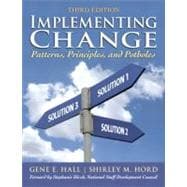A research-based guide for educators to the practical methods of understanding, evaluating and facilitating the change process.
Significantly revised based on student and instructor feedback, the new third edition of Implementing Change continues to examine the ways in which change processes are experienced by those "on the ground" while adding new features, new material and the most current research. Based primarily on the Concerns Based Adoption Model (CBAM), this user-friendly text focuses on introducing constructs that can be used by those engaged in facilitating change processes as well as those who are evaluating and studying change.
Rather than maintaining a bird’s eye view of change processes, each chapter introduces a research-based, research-verified construct about change that captures the complexity of implementing change and the diversity of reactions to it. With a stress on pedagogical aids, each chapter incorporates practical examples, sample research, case studies, reflection questions and examples of common roadblocks to change.
"I use this book because of its coverage of the skills required to make change happen." - Martha Burger, Midwestern State University
"The book should be required reading for all educators as each will be personally and professionally involved in a wide variety of change initiatives throughout their careers." -Christopher J. Quinn, Azusa Pacific University








